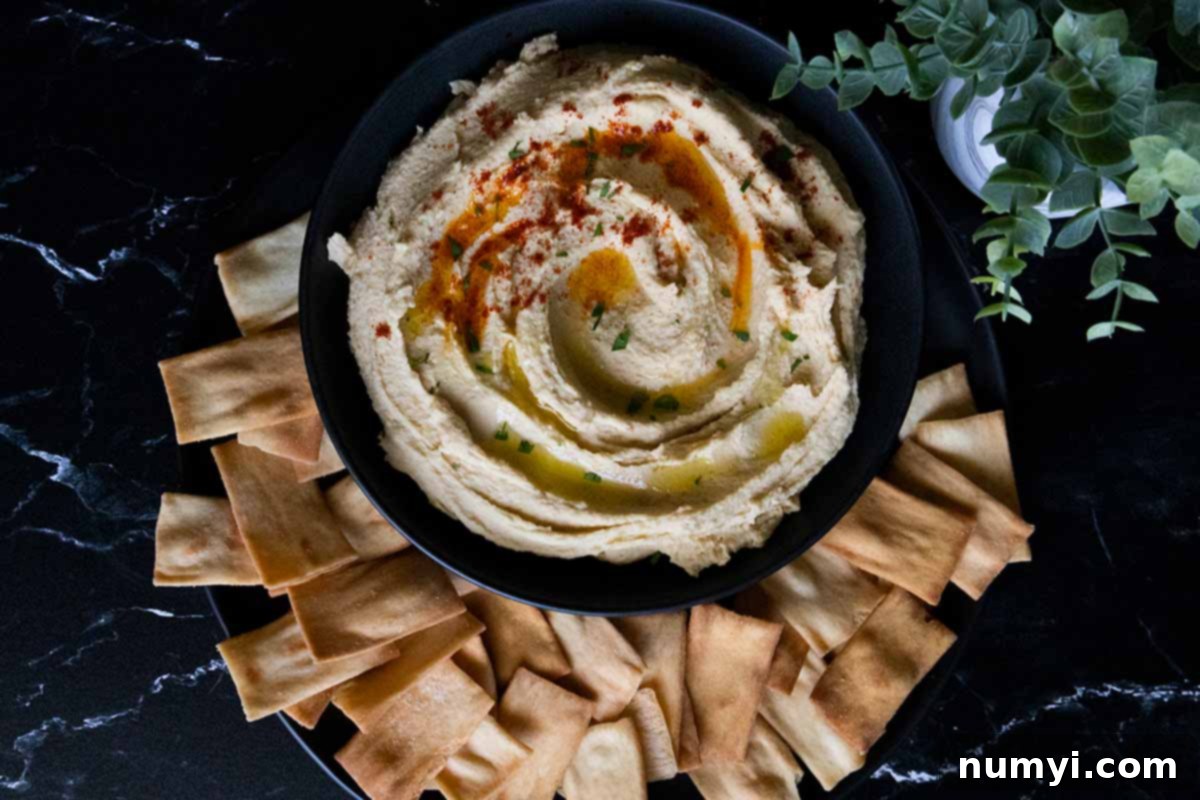Mastering Homemade Hummus: Your Guide to Super Creamy, Smooth, and Flavorful Dip
There’s nothing quite like the rich, creamy texture and vibrant flavor of freshly made hummus. While store-bought options are convenient, crafting your own homemade hummus from scratch elevates this classic Mediterranean dip to an entirely new level. Imagine a velvety smooth dip, bursting with zesty lemon, aromatic garlic, and nutty tahini, all perfectly balanced. This comprehensive guide will show you how to achieve that coveted smooth consistency and incredible flavor, whether you choose to peel your chickpeas or skip that step entirely.

Many recipes for ultra-smooth hummus suggest peeling the skins from each chickpea (garbanzo bean). While this can contribute to a smoother texture, the truth is, it’s an incredibly time-consuming and often unnecessary step for achieving truly luscious results. I’ve personally experimented with hand-peeling chickpeas, and while there was a subtle difference in smoothness, it wasn’t significant enough to justify the extensive effort. The key to a silky, creamy hummus often lies more in proper blending technique and the right combination of ingredients than in tedious chickpea preparation.
Forget the often bland and sometimes gummy consistency of supermarket hummus. This homemade version is remarkably fresher, more flavorful, and allows you complete control over every ingredient. You can adjust the seasoning, the tanginess, and the richness to perfectly suit your taste preferences, creating a truly personalized and superior dip.
For those who are determined to peel their chickpeas for the ultimate smoothness, rest assured, I’ll share a simple method to make the process easier and faster than individual peeling. However, if you’re looking for an equally delicious and much quicker path to creamy perfection, you’ll discover that a powerful food processor and adequate blending time are your best allies.

Why Homemade Hummus is Simply the Best
Diving into the world of homemade hummus is a game-changer for any food lover. Beyond the sheer satisfaction of creating something delicious from scratch, there are several compelling reasons why making your own hummus surpasses store-bought varieties:
- Unmatched Freshness: Store-bought hummus can often taste a bit flat or processed due to preservatives and longer shelf life. Homemade hummus, made with fresh ingredients, offers a vibrant, bright flavor that truly shines.
- Control Over Ingredients: You dictate exactly what goes into your dip. This means no artificial additives, unwanted oils, or excessive sodium. You can choose organic ingredients, adjust salt levels, and ensure it meets any dietary needs or preferences.
- Superior Texture: With the right technique, homemade hummus achieves an incredibly smooth and creamy consistency that’s hard to find in pre-packaged options. It’s rich without being heavy, and airy without being thin.
- Cost-Effective: Making hummus at home is significantly cheaper than buying it. Chickpeas, tahini, lemon, and garlic are all relatively inexpensive ingredients, allowing you to enjoy this healthy dip more frequently without breaking the bank.
- Endless Customization: Once you master the basic recipe, the possibilities for flavor variations are endless. Add roasted vegetables, different spices, or fresh herbs to create unique dips that cater to any palate or occasion.
Essential Ingredients for Perfect Hummus
Creating exceptional hummus starts with high-quality ingredients. Each component plays a vital role in achieving that signature flavor and luscious texture. Here’s what you’ll need, and why each item is important:
- Cooked Chickpeas (Garbanzo Beans) – The foundation of your hummus. While you can cook dried chickpeas from scratch (requiring an overnight soak and cooking until very soft, often with a pinch of baking soda to aid tenderness), canned chickpeas are a fantastic shortcut. They make the process significantly faster and easier without compromising flavor or texture, especially when rinsed thoroughly.
- Fresh Garlic – This is non-negotiable! Fresh garlic provides a pungent, aromatic kick that defines authentic hummus. Avoid garlic powder; its flavor simply can’t compare. For a milder, sweeter garlic note, consider roasting a few cloves beforehand.
- Fresh Lemon Juice – Crucial for brightness and acidity, fresh lemon juice cuts through the richness of the tahini and adds a refreshing tang. Bottled lemon juice often contains preservatives and lacks the vibrant flavor of freshly squeezed.
- Ground Cumin – A quintessential spice in Middle Eastern cuisine, ground cumin infuses the hummus with its warm, earthy, and slightly smoky undertones, providing that characteristic hummus flavor we all love. Adjust the amount to your preference.
- Tahini – Made from ground sesame seeds, tahini is arguably the second most important ingredient after chickpeas. It contributes a rich, nutty flavor and is essential for achieving the distinct creamy, emulsified texture of traditional hummus. Be sure to use a good quality tahini and stir it well before measuring, as the oil can separate.
- Extra Virgin Olive Oil – Beyond being a delicious topping, a good quality extra virgin olive oil is blended directly into the hummus to enhance its creaminess and add a subtle fruitiness. It also forms a beautiful drizzle for garnish.
- Kosher Salt – Salt is vital for seasoning and bringing out all the flavors. Start with a recommended amount (like 1/2 teaspoon) and taste as you go, adjusting until the hummus is perfectly seasoned. Kosher salt’s larger crystals allow for easier control.
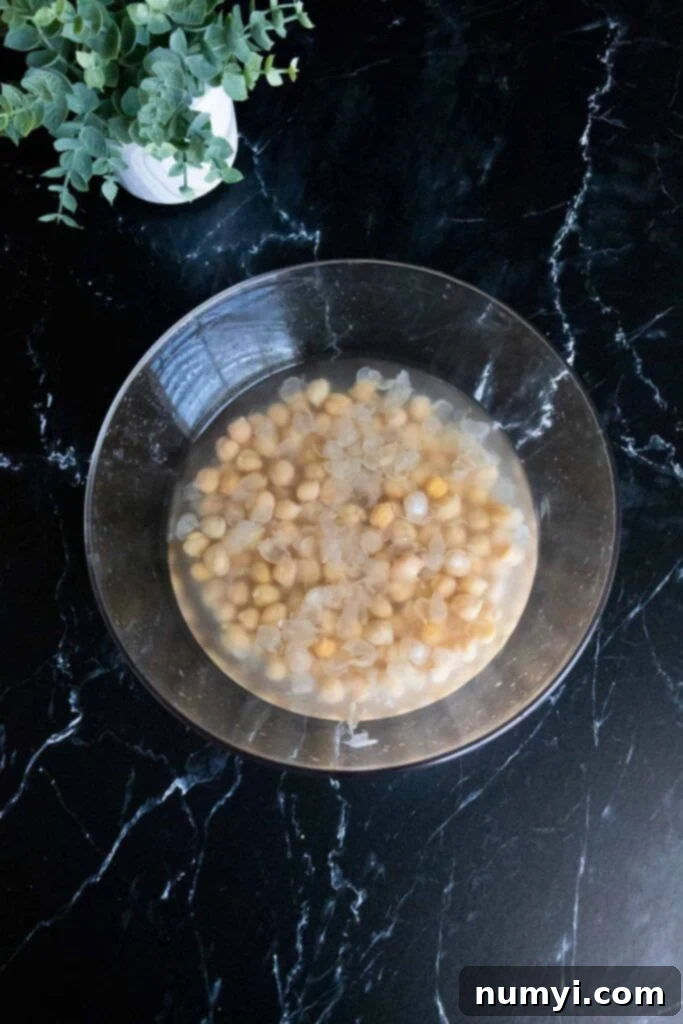
Crafting Your Easy Homemade Hummus: Step-by-Step
Making delicious, restaurant-quality hummus at home is surprisingly simple, especially when you follow these easy steps. The real secret lies in the blending!
Optional: Preparing and Skinning the Chickpeas for Ultimate Smoothness
If you’re aiming for an incredibly silky-smooth hummus, you might consider skinning the chickpeas. While not strictly necessary for a great dip, removing the fibrous outer skins can eliminate any trace of grittiness.
- Drain and Rinse: Start by draining and thoroughly rinsing your canned chickpeas under cold water. This removes excess sodium and any starchy liquid.
- Hot Water Soak: Transfer the rinsed chickpeas to a large bowl. Pour enough hot water over them to cover by about an inch. Let them soak for 5 to 10 minutes. This softens the skins and makes them easier to remove.
- Rub and Remove: Gently rub the chickpeas together between your hands in the water. The skins should start to loosen and float to the surface. Use a slotted spoon or your hands to scoop out and discard these detached skins. Drain the chickpeas well once most of the skins are removed.
Pro Tip: As mentioned earlier, skipping the skinning step is perfectly fine! The magic for truly smooth and creamy hummus mostly happens in the food processor. If you have a powerful machine, a long blend time often negates the need for this extra effort.
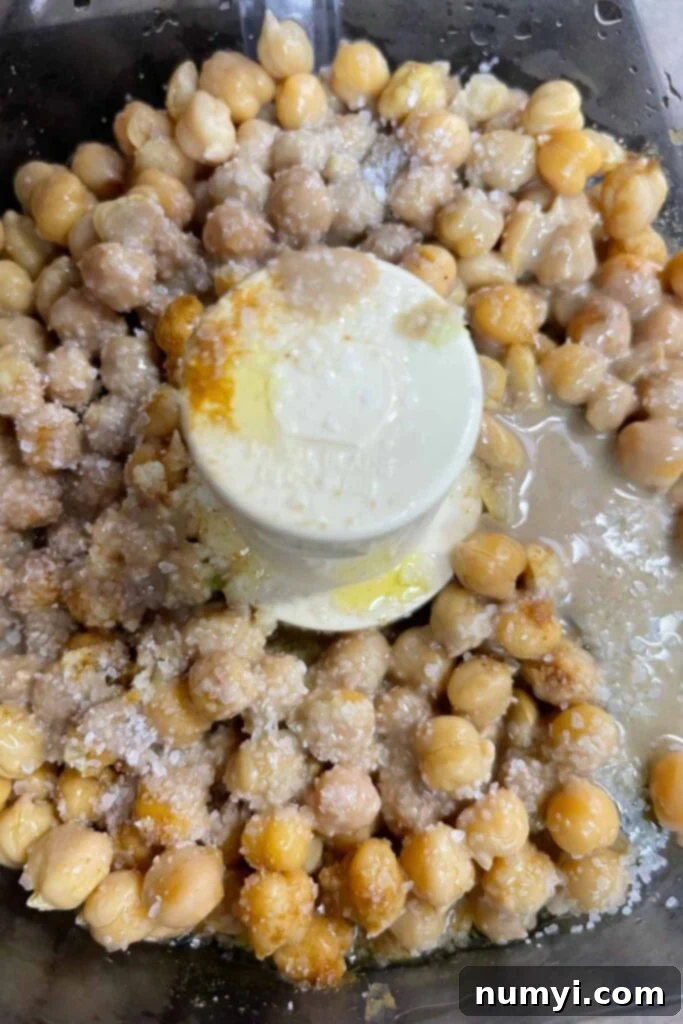
The Blending Process: The Secret to Silky Hummus
This is where your homemade hummus transforms from simple ingredients into a creamy delight. Don’t rush this step!
- Combine Ingredients: In the bowl of your food processor, combine the prepared chickpeas (skinned or unskinned), minced fresh garlic, fresh lemon juice, ground cumin, well-stirred tahini, extra virgin olive oil, and kosher salt.
- Process for Creaminess: Secure the lid and process the ingredients for a full 3 to 4 minutes. This extended blending time is the absolute trick to achieving that incredibly smooth and creamy hummus texture. Don’t be shy about letting the machine run. During this time, the chickpeas will break down completely, and the tahini and olive oil will emulsify beautifully.
- Scrape and Adjust: Stop the food processor occasionally to scrape down the sides of the bowl with a spatula. This ensures all ingredients are thoroughly incorporated and blended evenly.
- Achieve Desired Consistency: As you blend, assess the texture. If the hummus appears too thick or stiff, add a tablespoon or more of cold water (or even a few ice cubes for extra fluffiness!) one at a time, continuing to process until you reach your desired consistency. We often find the texture is perfect for our taste after the initial blending, but some prefer it a little thinner, akin to a pouring consistency.
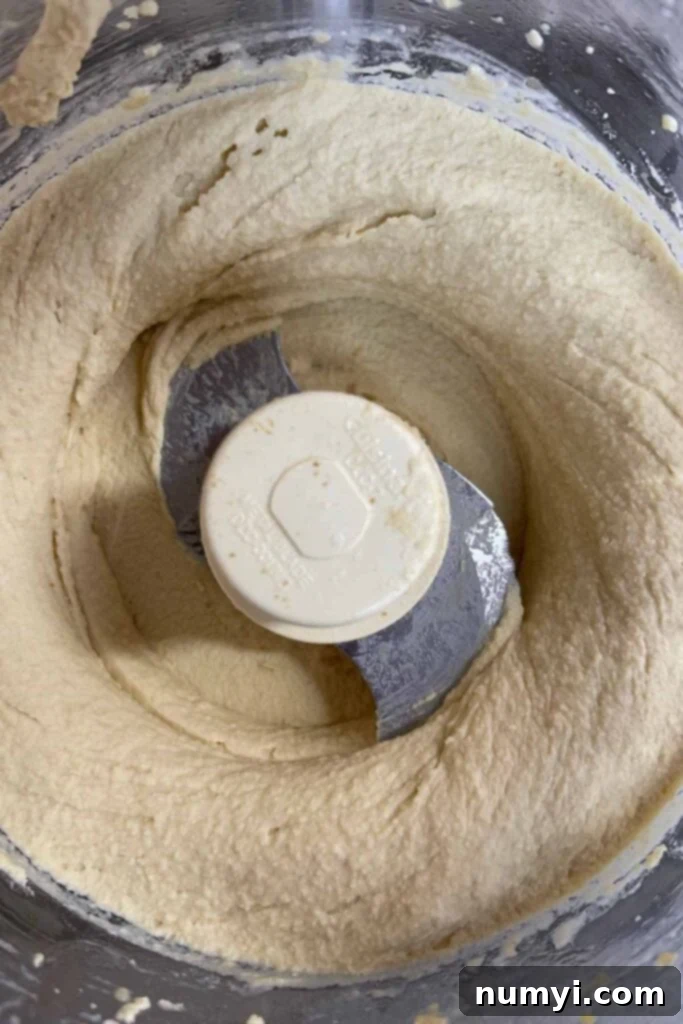
Serving Your Delicious Hummus
Once your hummus reaches its peak creaminess and flavor, it’s time for the final touches that make it truly irresistible.
Transfer the hummus to a beautiful serving bowl. Using the back of a spoon, create a shallow well or swirl in the center. Drizzle generously with a bit of extra virgin olive oil – this not only adds flavor but also a beautiful sheen. For a pop of color and extra flavor, sprinkle with a dash of paprika and some freshly chopped parsley. Other popular garnishes include a pinch of sumac, toasted pine nuts, or a few whole chickpeas.
Tips for the Smoothest Hummus Every Time
Beyond the basic steps, these extra tips can help you achieve hummus perfection:
- Use a Powerful Food Processor or Blender: A robust machine is crucial for breaking down the chickpeas completely. A high-speed blender can also work wonders, though you might need to add a bit more liquid to get it going.
- Warm Chickpeas: If you’re cooking dried chickpeas, blend them while they are still warm. Warm chickpeas tend to break down more easily, resulting in a smoother consistency. If using canned, rinsing them with warm water before blending can help.
- Add Cold Water Gradually: Instead of adding all the liquid at once, incorporate cold water (or ice water) slowly, a tablespoon at a time, until you reach your desired texture. This helps keep the hummus cool and prevents it from overheating, which can affect the texture.
- Good Quality Tahini: The type of tahini makes a difference. Look for a tahini with a smooth, pourable consistency and a mild, nutty flavor. Thicker, more pasty tahini can make your hummus dense.
- Don’t Skimp on Lemon Juice: Fresh lemon juice is key for balancing the richness and brightening the flavor. If your hummus tastes dull, often more lemon juice is the answer.
Serving Suggestions for Your Homemade Hummus
Hummus is incredibly versatile and pairs well with a myriad of foods. Here are some classic and creative ways to enjoy your freshly made dip:
- Pita Chips & Pita Bread – A timeless classic! Serve with crispy pita chips or warm, soft pita bread. For an extra treat, lightly toast pita bread brushed with a little olive oil until golden.
- Fresh Vegetables – A healthy and refreshing option. Think crisp bell pepper strips, crunchy celery sticks, carrot sticks, cucumber slices, cherry tomatoes, or even radish rounds.
- Crackers – A simple yet satisfying pairing for a quick snack or appetizer.
- Sandwiches & Wraps – Elevate your lunch by slathering a generous layer of hummus on your sandwiches, wraps, or even burgers for added moisture, flavor, and nutrition.
- Salad Topping – Thin out your hummus with a little extra lemon juice or water to create a creamy, flavorful salad dressing.
- Breakfast Toast – Spread hummus on whole-wheat toast and top with avocado, a fried egg, or everything bagel seasoning for a unique breakfast.
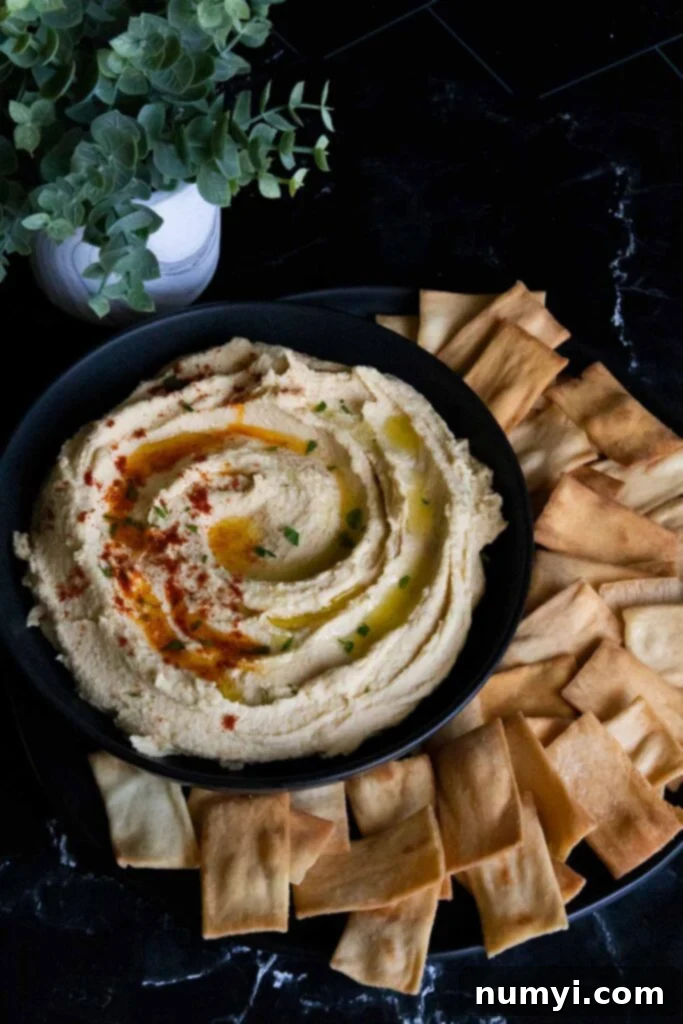
Creative Hummus Variations to Explore
Once you’ve mastered the basic recipe, don’t hesitate to get creative with flavor additions:
- Roasted Garlic Hummus – For a deeper, sweeter garlic flavor, roast a whole head of garlic until soft and caramelized before adding the cloves to your food processor.
- Roasted Red Pepper Hummus – Blend in 1/2 cup to 3/4 cup of drained and chopped roasted red peppers (from a jar or homemade) for a smoky, sweet, and vibrant dip.
- Kalamata Olive Hummus – Add about 3/4 cup of pitted and chopped Kalamata olives for a briny, Mediterranean twist.
- Pesto Swirl Hummus – Swirl a dollop of your favorite store-bought or homemade pesto into the finished hummus for an herby, aromatic variation.
- Spicy Hummus – Incorporate a pinch of cayenne pepper, red pepper flakes, or a dash of hot sauce into the mix.
- Herbaceous Hummus – Blend in fresh cilantro, mint, or dill for a bright, fresh flavor profile.
More Delicious Dip Recipes to Try
- Easy Spinach Dip
- Artichoke Dip
- Easy Mediterranean Dip
- Easy Black Bean Dip
- Fresh Herb Vegetable Dip
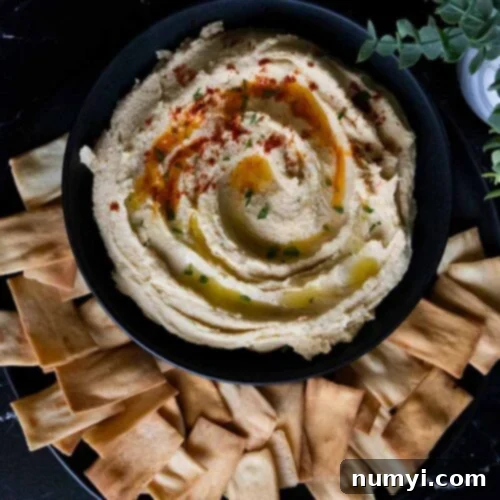
Easy Homemade Hummus Recipe
Print
Pin
Rate
Ingredients
- 30 oz Chickpeas (garbanzo beans) 2 cans
- 2 cloves Garlic minced
- 1/4 cup Fresh lemon juice
- 1/2 tsp Cumin more or less to taste
- 1/4 cup Tahini well stirred
- 3 tbsp Extra virgin olive oil extra for garnish
- 1/2 tsp Kosher salt or more to taste
Instructions
-
To Skin the Chickpeas (Optional for extra smoothness): Drain and rinse the chickpeas. Place in a large bowl and pour enough hot water to cover the peas by about 1-inch. Let soak for 5 to 10 minutes. Gently rub the chickpeas together in the water. The skins should come off easily and float to the top of the water. Remove them with a slotted spoon or just your hands and discard.30 oz Chickpeas (garbanzo beans)
-
In the bowl of a food processor, combine the chickpeas (prepared as desired), minced garlic, fresh lemon juice, cumin, tahini, olive oil, and salt.2 cloves Garlic, 1/4 cup Fresh lemon juice, 1/2 tsp Cumin, 1/4 cup Tahini, 3 tbsp Extra virgin olive oil, 1/2 tsp Kosher salt
-
Process for 3 to 4 minutes until smooth and creamy. Stop periodically to scrape down the sides of the bowl. If the hummus is too thick, add a tablespoon or more of cold water until you reach your desired consistency.
-
Transfer the hummus to a serving bowl. Using the back of a spoon, swirl a shallow well in the center. Drizzle with a little extra olive oil and sprinkle with paprika and chopped fresh parsley for garnish.
